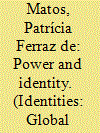| Srl | Item |
| 1 |
ID:
184812


|
|
|
|
|
| Summary/Abstract |
The essay explores the entangled relationship between modernization and women's visibility and representation through three pictorial spheres most redolent of that relationship: photo studio culture (1880s–1930s), satirical cartoons (1920–58), and costume exhibition (1972–76). The study prioritizes minoritarian politics formulated by women through their organizations and public activities, whether charitable in the late nineteenth century, educational in the early twentieth century, or “civilizational” from the mid-twentieth century on. By examining pictorial and textual sources, it proposes that the Armenian woman as a discursive phenomenon was central to Iran's mainstream modernization and foregrounds the complex working of a double marginality to the processes, strategies, and anxieties of late Qajar and Pahlavi modernization.
|
|
|
|
|
|
|
|
|
|
|
|
|
|
|
|
| 2 |
ID:
129970


|
|
|
|
|
| Publication |
2014.
|
| Summary/Abstract |
This article reflects on the inclusion of human beings in the colonial representations of the great exhibitions that Portugal organised or took part in during the first half of the twentieth century. It analyses the role played by the natives (from the Portuguese colonies), as well as the way they were represented and treated, based on various documents and interviews and on the study of the exhibition creation process. These exhibitions revealed some underlying tensions. On the one hand, they provided evidence of the differences between the 'civilised' and the 'uncivilised', of the diversity of 'races' and of their places in a hierarchy of civilisation. On the other, they extolled the way colonised peoples adopted Portuguese models. The ways those human beings have asserted their existence, under the power of the exhibition's organisers, provides a means to understand how they forged and assumed their identities in a context of rules.
|
|
|
|
|
|
|
|
|
|
|
|
|
|
|
|